Innisfree

 Innisfree is a naturalistic garden in the Hudson River Valley inspired by the 8th century garden of Wang Wei.
Innisfree is a naturalistic garden in the Hudson River Valley inspired by the 8th century garden of Wang Wei. 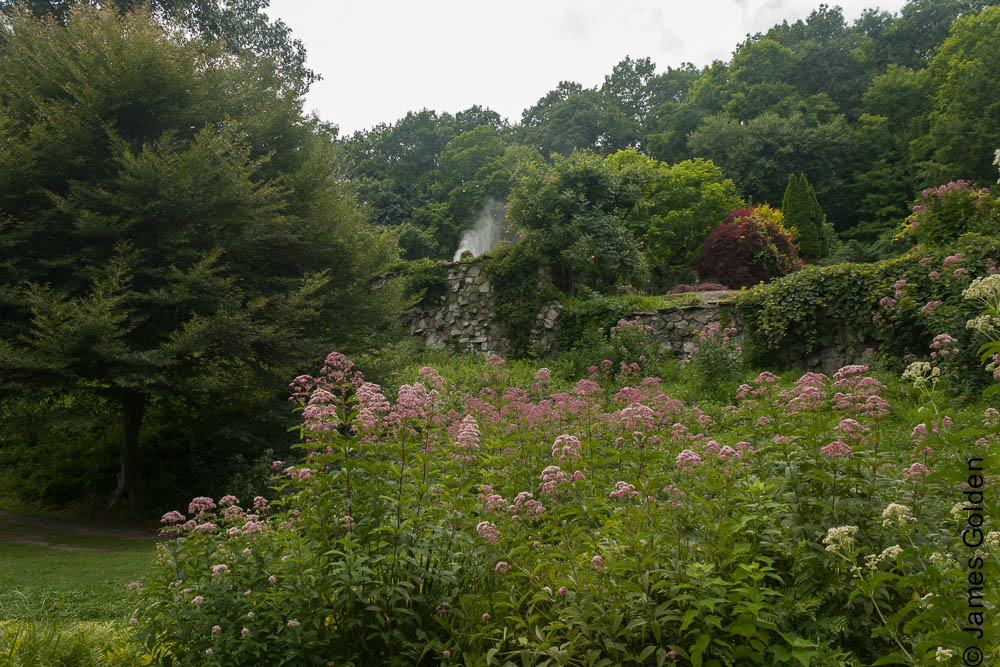 The garden reveals itself slowly as you walk its multiple paths, experience the layered hills and valleys, participate in many smaller gardens as they coalesce around you, as well as long views into the misty distance, as you contemplate naturally sculpted rocks, carefully placed. This is a landscape garden that must be walked and experienced.
The garden reveals itself slowly as you walk its multiple paths, experience the layered hills and valleys, participate in many smaller gardens as they coalesce around you, as well as long views into the misty distance, as you contemplate naturally sculpted rocks, carefully placed. This is a landscape garden that must be walked and experienced.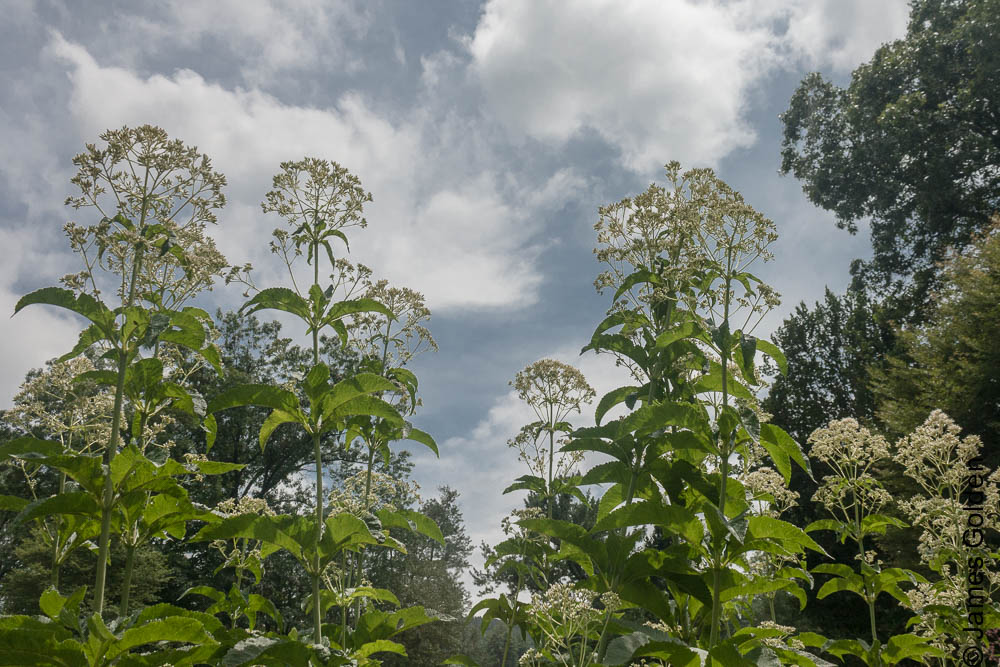 It is a garden of the mind; your mind and sensibility create and recreate it as you move through the landscape. You have to wander. There is no direct path through, and no specific destination, no starting point or ending point. You make constant choices and changes in route.
It is a garden of the mind; your mind and sensibility create and recreate it as you move through the landscape. You have to wander. There is no direct path through, and no specific destination, no starting point or ending point. You make constant choices and changes in route. Innisfree is known locally, and by some who appreciate extraordinary gardens around the world, but I think few have visited it. Rory Stuart in his recent book "What are gardens for?" listed it as one of the ten best gardens in the world (admittedly, a "conversation starter" list, not meant to be seriously definitive).
Innisfree is known locally, and by some who appreciate extraordinary gardens around the world, but I think few have visited it. Rory Stuart in his recent book "What are gardens for?" listed it as one of the ten best gardens in the world (admittedly, a "conversation starter" list, not meant to be seriously definitive). 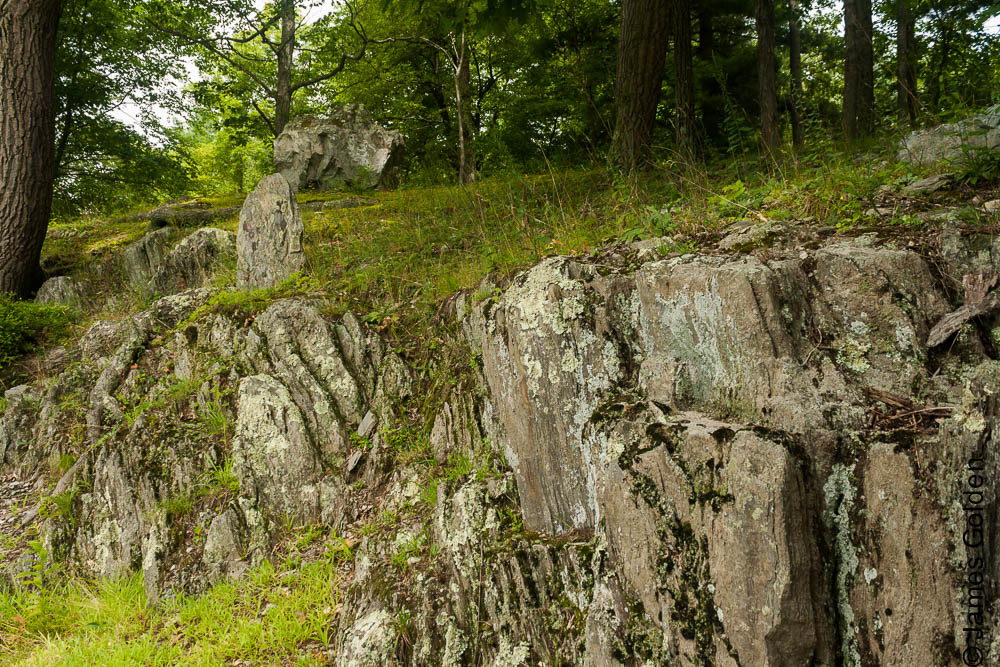 Others have appreciated it too ...
Others have appreciated it too ... "Like the pyramids of Egypt or the Great Wall of China, Innisfree helps us to define what we mean by ‘civilization’. It’s one of the few places in this world that lived up to — nay, exceeded — my expectations." --David Wheeler, Editor, Hortus (2013)
"Like the pyramids of Egypt or the Great Wall of China, Innisfree helps us to define what we mean by ‘civilization’. It’s one of the few places in this world that lived up to — nay, exceeded — my expectations." --David Wheeler, Editor, Hortus (2013) 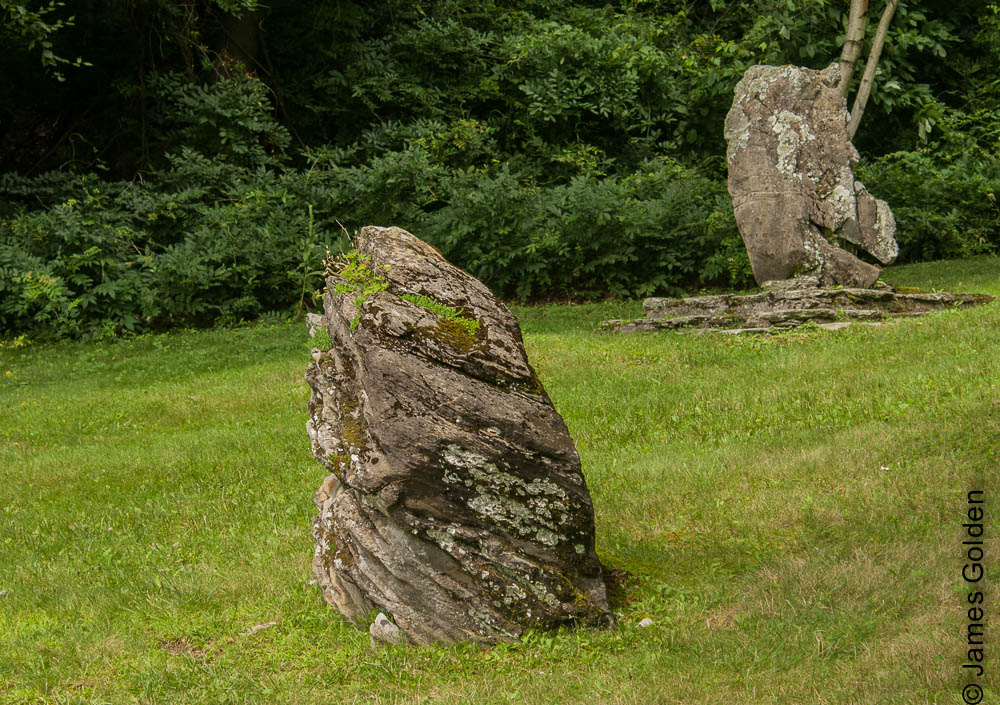 Innisfree's creation was the work of several decades of sometimes massive manipulation of the land surface and rock, as well as many years of thought, gentle watching and waiting, and minimal planting.
Innisfree's creation was the work of several decades of sometimes massive manipulation of the land surface and rock, as well as many years of thought, gentle watching and waiting, and minimal planting.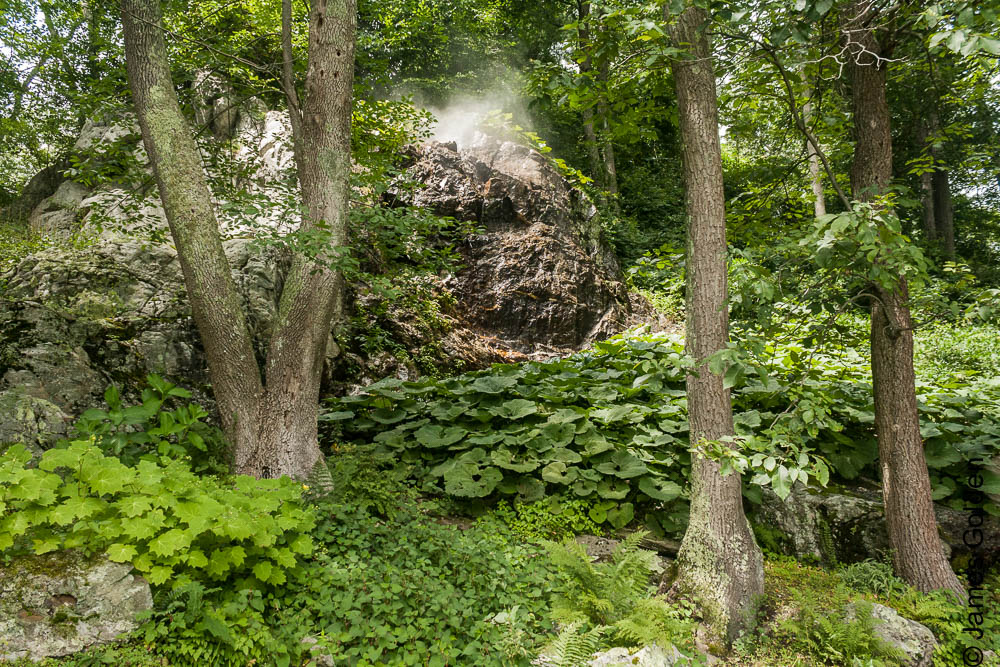 The Innisfree landscape is a glacial lake encircled by low hills -- a natural bowl of water, earth, forest, sky. On first view, it appears to be a natural landscape, but it isn't. This is landscape as palimpsest ... literally ... metaphorical "writings" have been erased by time or intention, and new writings added over the ancient glacial surface. It reveals layer upon layer of geology, time, and culture.
The Innisfree landscape is a glacial lake encircled by low hills -- a natural bowl of water, earth, forest, sky. On first view, it appears to be a natural landscape, but it isn't. This is landscape as palimpsest ... literally ... metaphorical "writings" have been erased by time or intention, and new writings added over the ancient glacial surface. It reveals layer upon layer of geology, time, and culture. Innisfree today is the result of many decades of work clarifying and perfecting a glacial terrain created over millennia, using a garden concept borrowed from the 8th century and an entirely alien culture. While its development over the latter six decades of the 20th century still shows the inexorable sculpting by natural forces in the last ice age, relatively recent human interventions have made it the graceful, at times so-subtle-as-to-be-almost-imperceptible, masterpiece we see today.
Innisfree today is the result of many decades of work clarifying and perfecting a glacial terrain created over millennia, using a garden concept borrowed from the 8th century and an entirely alien culture. While its development over the latter six decades of the 20th century still shows the inexorable sculpting by natural forces in the last ice age, relatively recent human interventions have made it the graceful, at times so-subtle-as-to-be-almost-imperceptible, masterpiece we see today.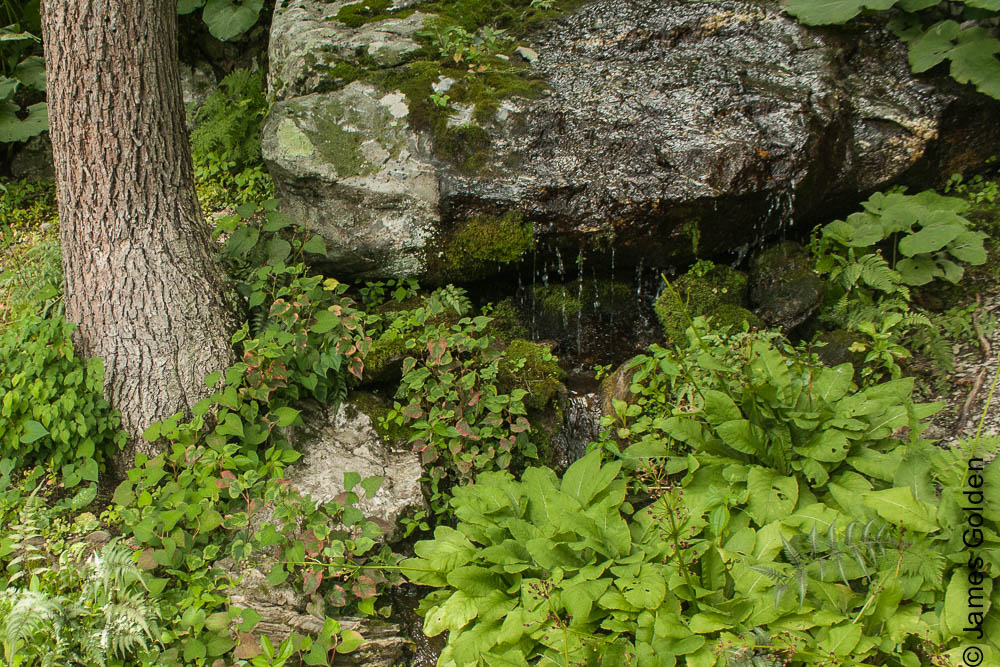 I first visited Innisfree in early August of this year. Actually, I had two introductions.
I first visited Innisfree in early August of this year. Actually, I had two introductions. The first, late in the afternoon just as a violent thunderstorm was approaching, gave me a glimpse of the entry walk, a mist fountain high in rocks dramatically underplanted with cimicifuga and petasites (all Innisfree plantings are simple), a walk up rough stone stairs, then a brief apparition of a small valley filled with mauve and white Joe Pye Weed taller than I've even seen before. In the distance was a rock terrace and another mist cloud that I couldn't make out, as rain started to fall in sheets, and we ran the distance back to the entry and the protection of the car.
The first, late in the afternoon just as a violent thunderstorm was approaching, gave me a glimpse of the entry walk, a mist fountain high in rocks dramatically underplanted with cimicifuga and petasites (all Innisfree plantings are simple), a walk up rough stone stairs, then a brief apparition of a small valley filled with mauve and white Joe Pye Weed taller than I've even seen before. In the distance was a rock terrace and another mist cloud that I couldn't make out, as rain started to fall in sheets, and we ran the distance back to the entry and the protection of the car.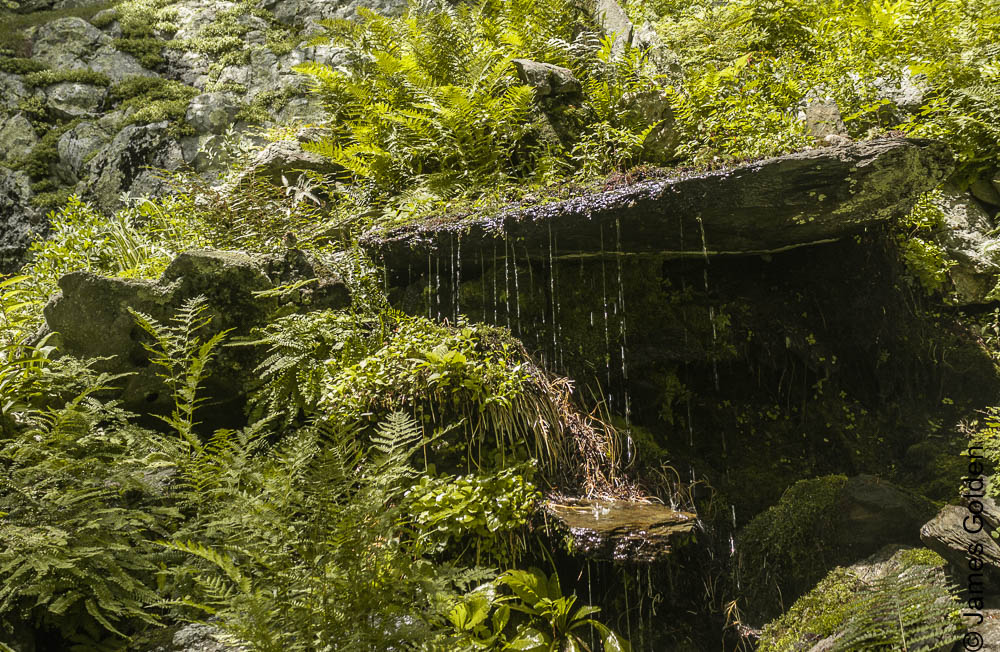 But in those few minutes I saw enough to know this was a transcendent place. The brief glimpse, because it awakened a longing to see more, quickly entangled my feelings and imagination, perhaps even more so than the much longer visit to the garden the next day.
But in those few minutes I saw enough to know this was a transcendent place. The brief glimpse, because it awakened a longing to see more, quickly entangled my feelings and imagination, perhaps even more so than the much longer visit to the garden the next day.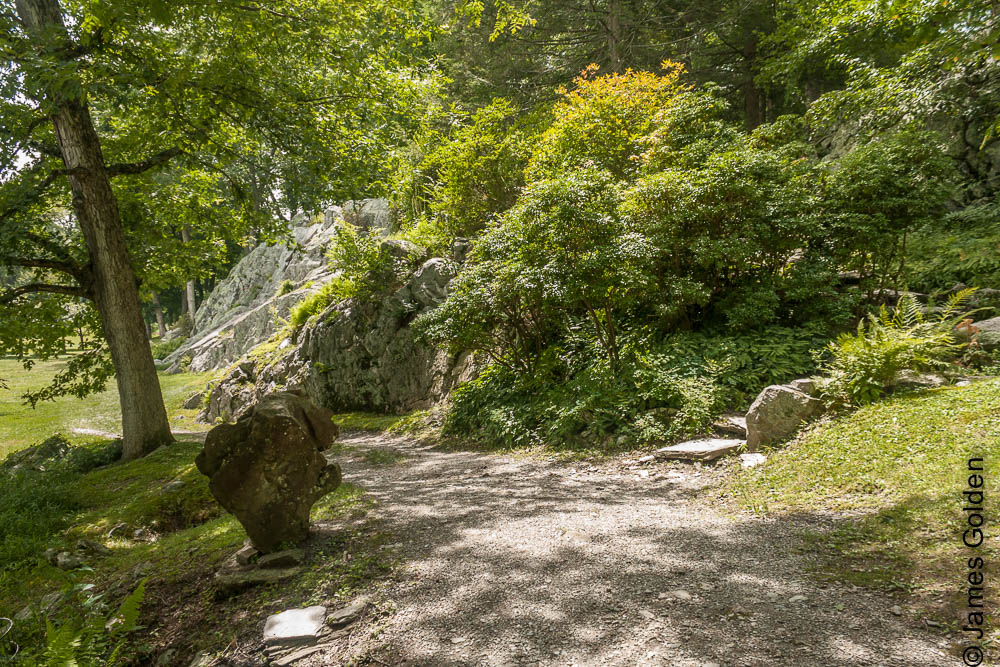 The making of Innisfree was a distillation, interpretation, and amplification of ideas taken from natural landscape, human thought and feeling, culture, and aesthetics. Its subtle beauty and the experience of walking its many paths, feels like exploring a natural landscape, but a nature improved and enhanced, almost invisibly, by feeling and abstract thought.
The making of Innisfree was a distillation, interpretation, and amplification of ideas taken from natural landscape, human thought and feeling, culture, and aesthetics. Its subtle beauty and the experience of walking its many paths, feels like exploring a natural landscape, but a nature improved and enhanced, almost invisibly, by feeling and abstract thought.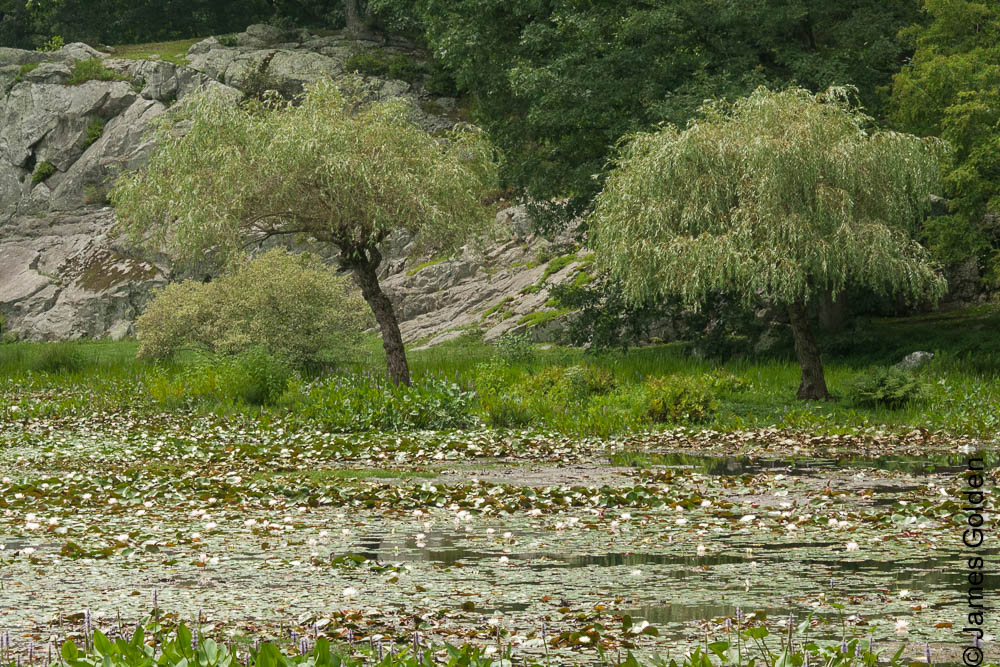 Innisfree quickly raises the question: What is natural?
Innisfree quickly raises the question: What is natural? Innisfree does not represent preservation or restoration of a natural landscape in any sense. It uses what is best in the landscape, and through highly contrived means, makes the new a seamless amalgam with the old, and presents to us a garden that appears to be almost untouched landscape. Hills have been shaped and contoured, rocks of great natural beauty and character found and carefully positioned, terraces built and planted, water falls created, a high reservoir built to supply fountains, sprays and mists, a stream reshaped to create wetlands and--through intensive labor--sculpted to imitate the winding, seemingly effortless bends of a river, walking bridges built, trees planted, some in groups, and some sculpted into intentional shapes, some formal, some not.
Innisfree does not represent preservation or restoration of a natural landscape in any sense. It uses what is best in the landscape, and through highly contrived means, makes the new a seamless amalgam with the old, and presents to us a garden that appears to be almost untouched landscape. Hills have been shaped and contoured, rocks of great natural beauty and character found and carefully positioned, terraces built and planted, water falls created, a high reservoir built to supply fountains, sprays and mists, a stream reshaped to create wetlands and--through intensive labor--sculpted to imitate the winding, seemingly effortless bends of a river, walking bridges built, trees planted, some in groups, and some sculpted into intentional shapes, some formal, some not.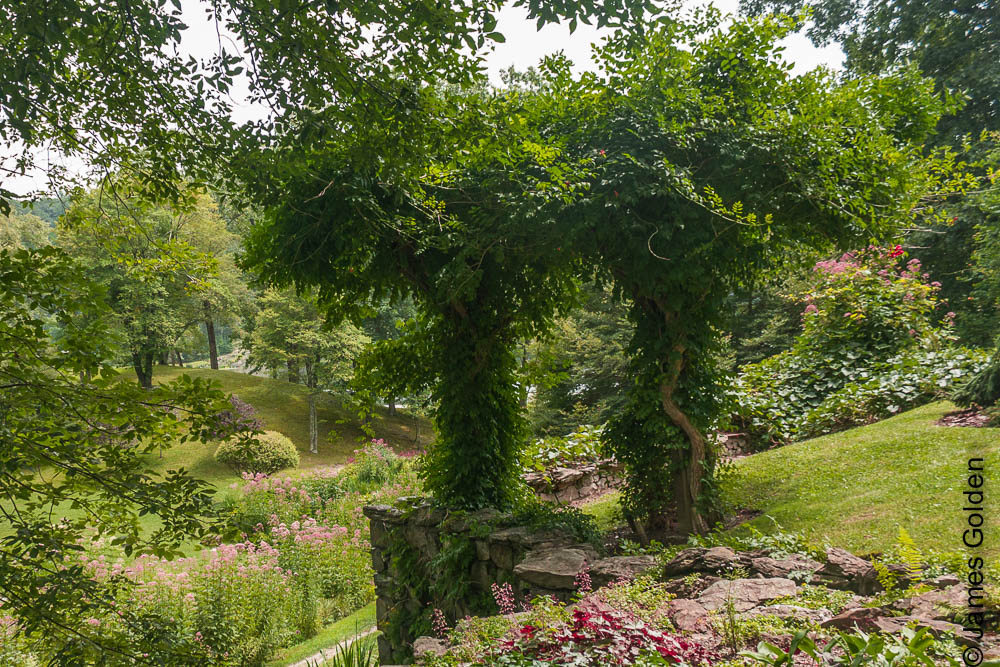 Comparison with another landscape created by massive reshaping of the earth, Charles Jenck's Garden of Cosmic Speculation, shows the latter in an almost vulgar light, like some carnival of latter day physics illustrated in gaudy, three-dimensional swirls and flourishes -- a thing imposed on the land, not one with it.
Comparison with another landscape created by massive reshaping of the earth, Charles Jenck's Garden of Cosmic Speculation, shows the latter in an almost vulgar light, like some carnival of latter day physics illustrated in gaudy, three-dimensional swirls and flourishes -- a thing imposed on the land, not one with it. After rejecting plans for an English landscape garden in the style of Lancelot 'Capability' Brown or Humphrey Repton originally planned to adorn the large house they had modeled on the Queen Anne style building of the Royal Horticultural Society at Wisley, Walter and Marion Beck had a change of mind, perhaps a moment of grace that turned their minds in an entirely different direction.
After rejecting plans for an English landscape garden in the style of Lancelot 'Capability' Brown or Humphrey Repton originally planned to adorn the large house they had modeled on the Queen Anne style building of the Royal Horticultural Society at Wisley, Walter and Marion Beck had a change of mind, perhaps a moment of grace that turned their minds in an entirely different direction. In 1930, when they decided to make a very different kind of garden on this site, it was too late to build a different kind of house, but they altered their plans for the garden and began a period of study in Europe.
In 1930, when they decided to make a very different kind of garden on this site, it was too late to build a different kind of house, but they altered their plans for the garden and began a period of study in Europe. There they eventually discovered the landscape paintings of Wang Wei, an 8th century Chinese painter, poet, and garden builder.
There they eventually discovered the landscape paintings of Wang Wei, an 8th century Chinese painter, poet, and garden builder.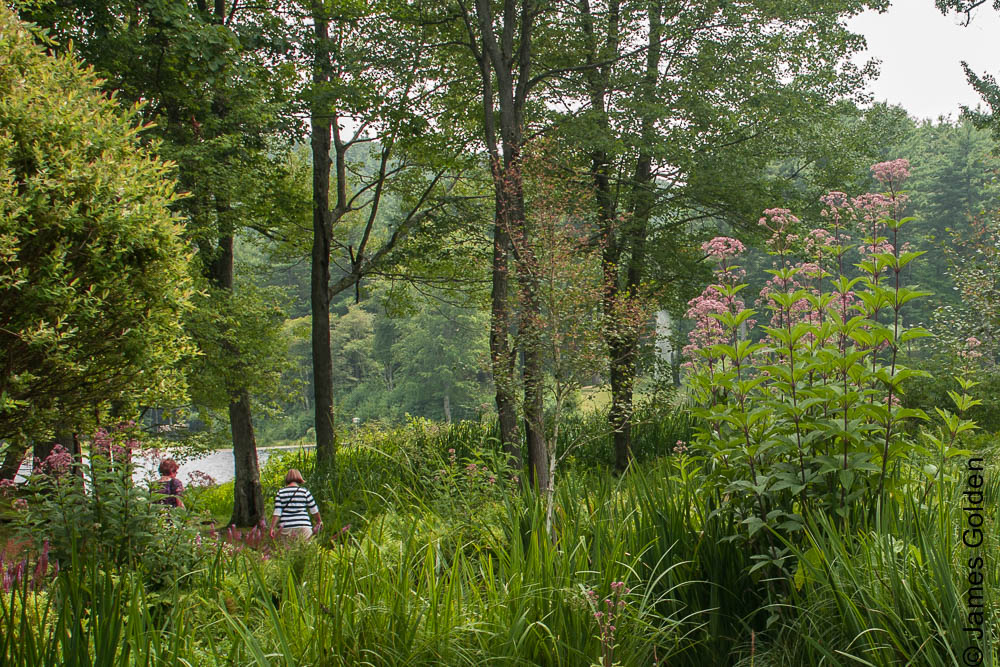 The Becks had no interest in creating a Chinese garden but Walter Beck perceived a design principle at work in Wang Wei's garden--individual gardens visually enclosed like cups. Beck coined the term "cup garden" to describe this, and it became his design motif throughout his development of Innisfree.
The Becks had no interest in creating a Chinese garden but Walter Beck perceived a design principle at work in Wang Wei's garden--individual gardens visually enclosed like cups. Beck coined the term "cup garden" to describe this, and it became his design motif throughout his development of Innisfree. In a meeting that was to profoundly affect the development of Innisfree, the Becks met Lester Collins, a student in landscape architecture at the Harvard Graduate School of Landscape Design, at a lecture on Chinese gardens in 1938.
In a meeting that was to profoundly affect the development of Innisfree, the Becks met Lester Collins, a student in landscape architecture at the Harvard Graduate School of Landscape Design, at a lecture on Chinese gardens in 1938.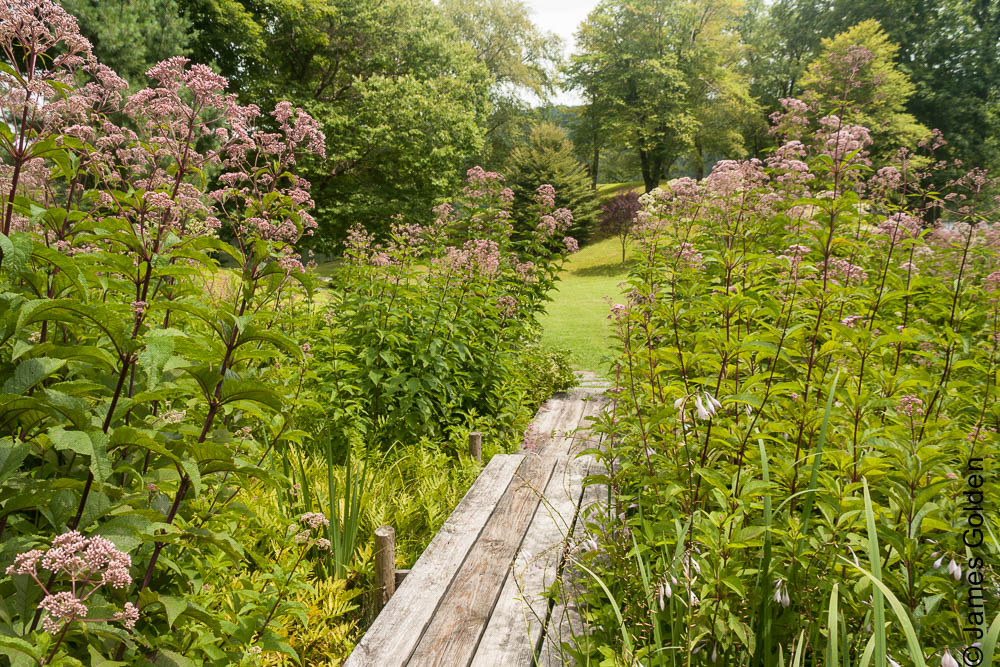 Collins, who by that time had become head of the Harvard Graduate School of Landscape Design, became the Beck's informal advisor and upon Walter Beck's death in 1954, Marion asked him to help her plan the garden's future. She died five years later, leaving the garden in Collins' hands for the next 45 years.
Collins, who by that time had become head of the Harvard Graduate School of Landscape Design, became the Beck's informal advisor and upon Walter Beck's death in 1954, Marion asked him to help her plan the garden's future. She died five years later, leaving the garden in Collins' hands for the next 45 years.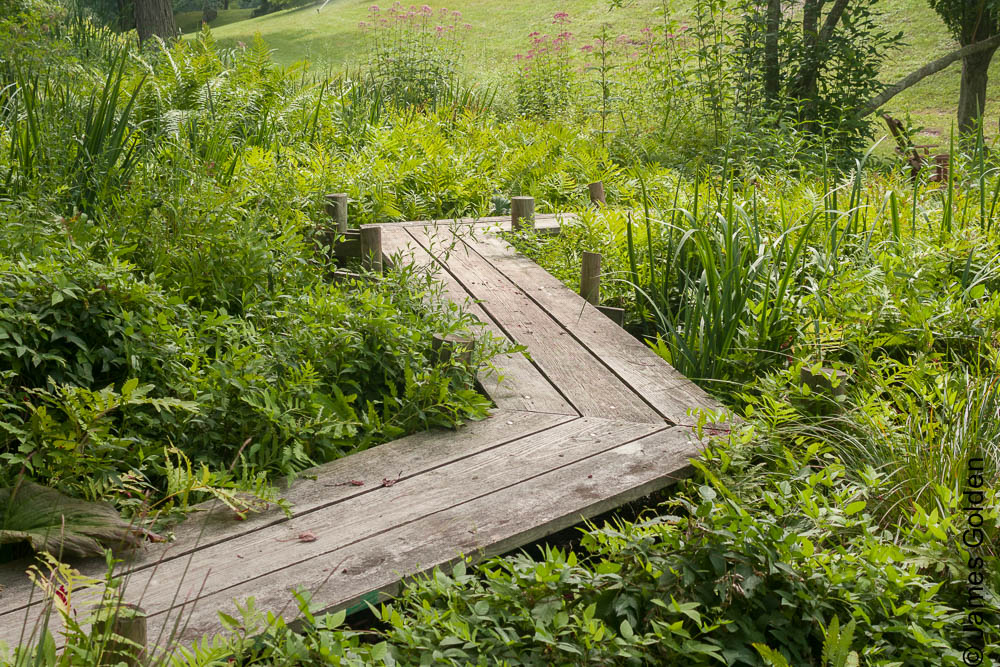 Much of the garden we see today is the work of Collins. He realized the garden couldn't survive as a public garden in the smaller, more intricate form that existed in the 1950s, so be began a process of expansion and simplification.
Much of the garden we see today is the work of Collins. He realized the garden couldn't survive as a public garden in the smaller, more intricate form that existed in the 1950s, so be began a process of expansion and simplification.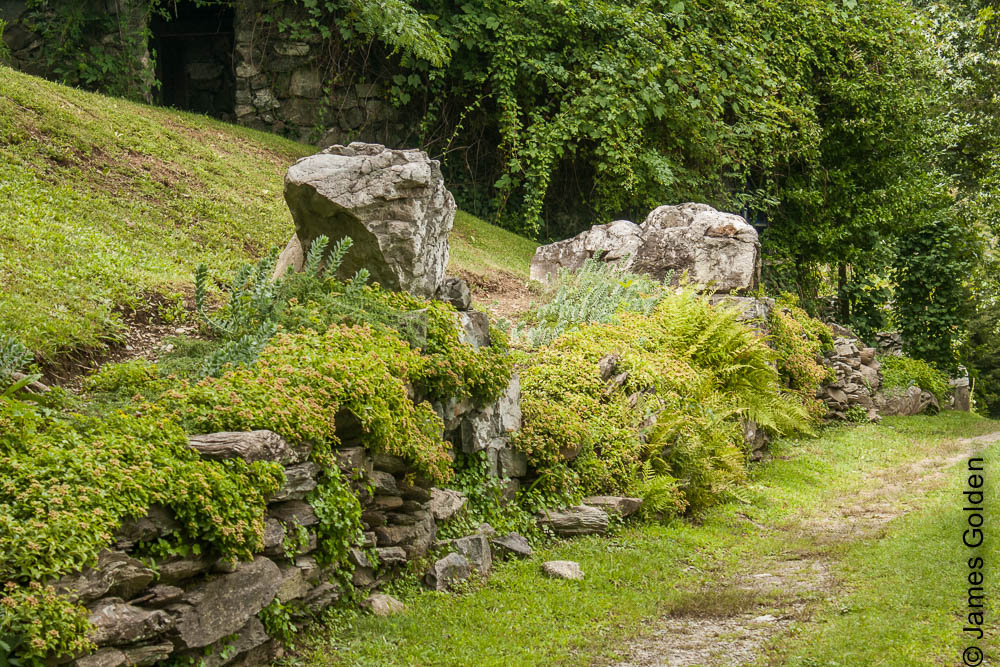 Even more important, he reinterpreted Walter Beck's concept of many individual "cup" gardens to encompass the entire landscape. He also introduced massive changes to expose a high rock cliff, and began a process of managing the edge of the lake, making it a centerpiece of Innisfree, whereas it had been only an occasional adjunct to views from the smaller garden around the house.
Even more important, he reinterpreted Walter Beck's concept of many individual "cup" gardens to encompass the entire landscape. He also introduced massive changes to expose a high rock cliff, and began a process of managing the edge of the lake, making it a centerpiece of Innisfree, whereas it had been only an occasional adjunct to views from the smaller garden around the house.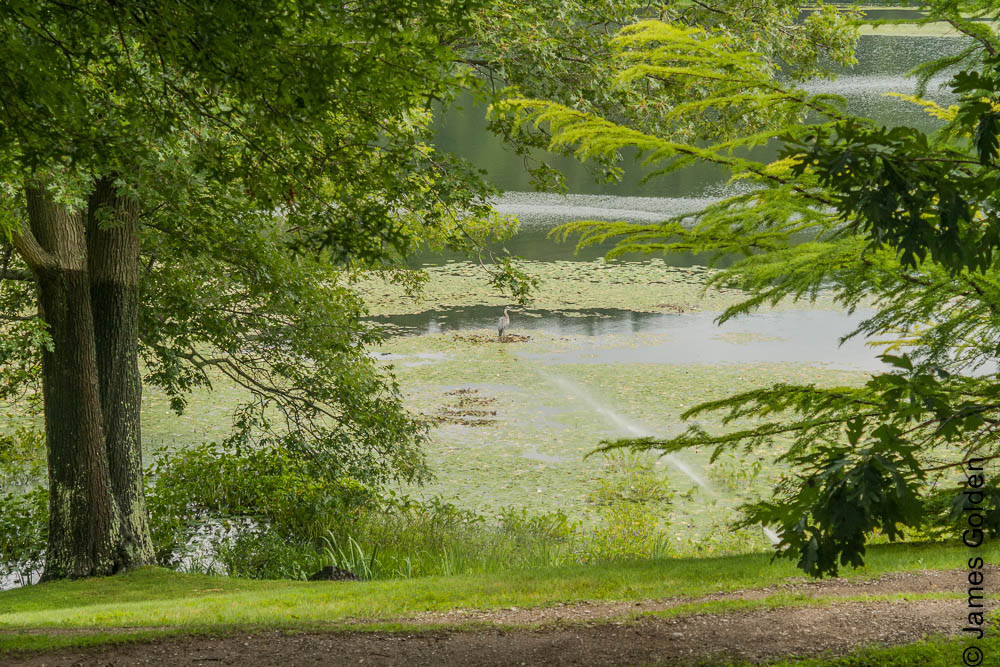 Because the large house was an intrusion on the garden as it had developed, he worked with the Innisfree board of directors to demolish the house and incorporate its foundations into a high terraced hillside.
Because the large house was an intrusion on the garden as it had developed, he worked with the Innisfree board of directors to demolish the house and incorporate its foundations into a high terraced hillside.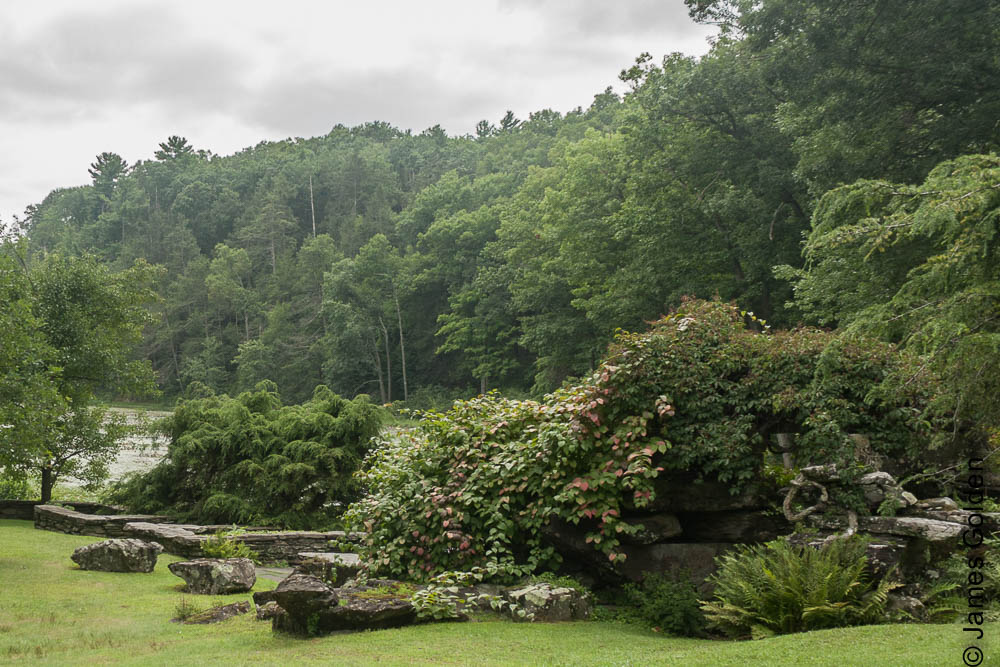 The story of the garden is told in "Innisfree: An American Garden" by Lester Collins. The book is still widely available from used book dealers.
The story of the garden is told in "Innisfree: An American Garden" by Lester Collins. The book is still widely available from used book dealers.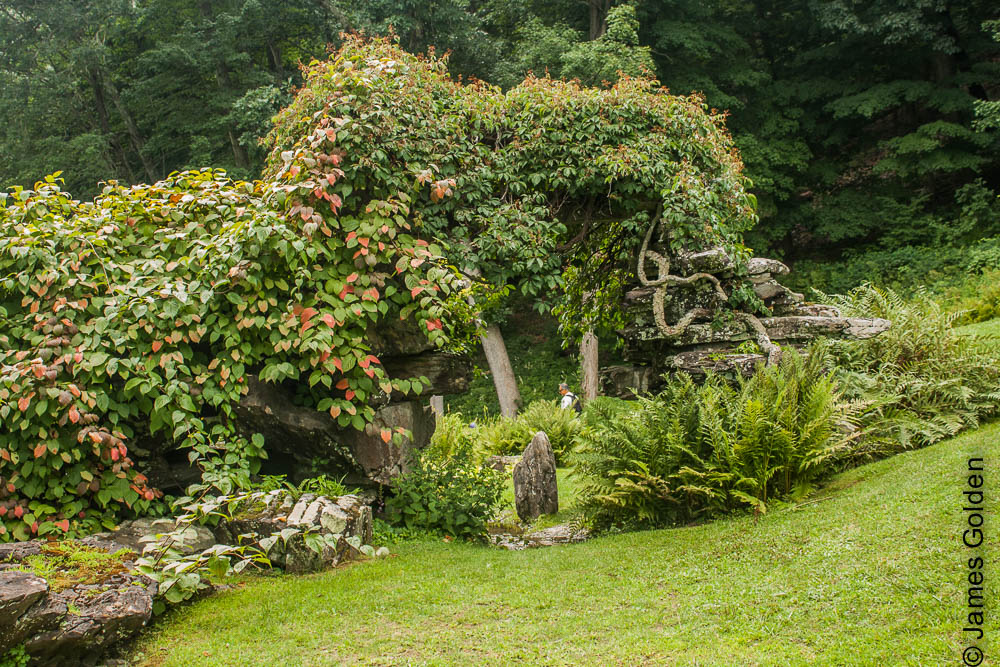
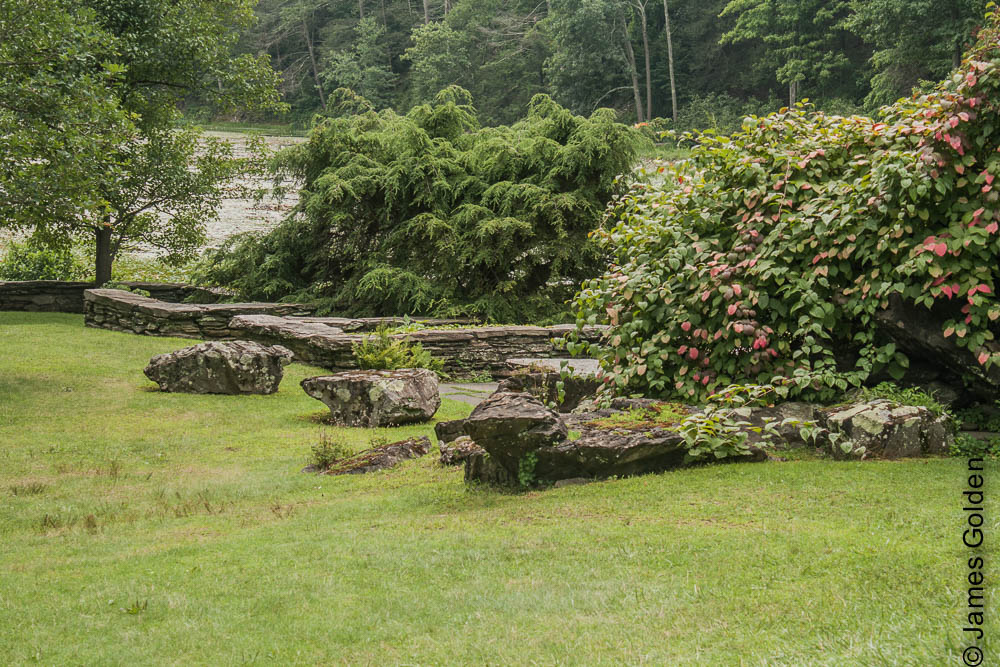 My companions, across the water ...
My companions, across the water ... The Point with Turtle Rock (left), Dragon Rock (center), and Owl Rock (right) ...
The Point with Turtle Rock (left), Dragon Rock (center), and Owl Rock (right) ...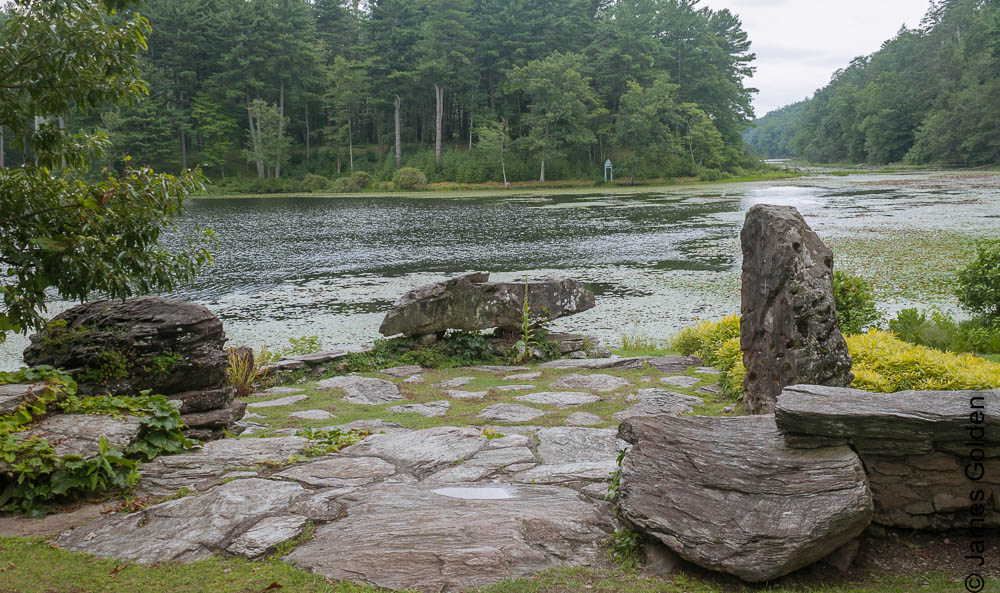
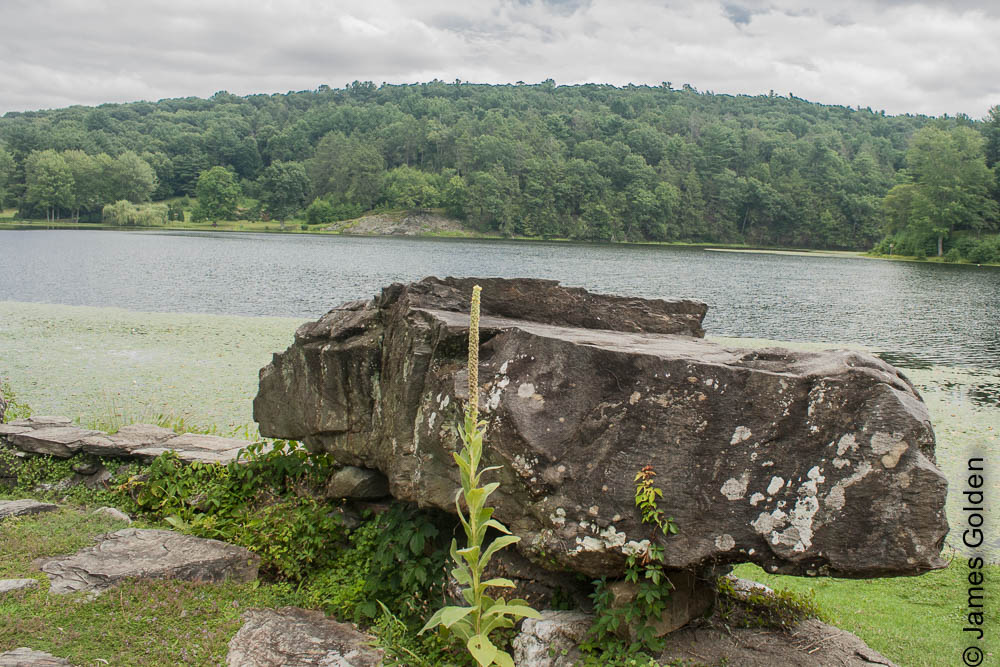 Entrance to The Point ...
Entrance to The Point ...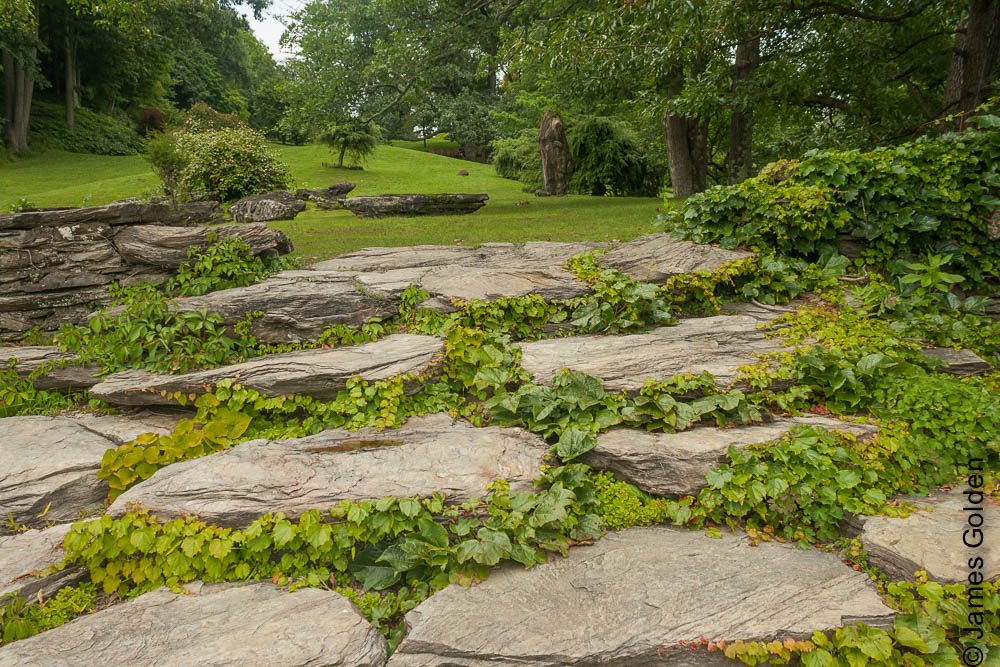 Button bush (Cephalanthus occidentalis) ...
Button bush (Cephalanthus occidentalis) ... The water spout ...
The water spout ...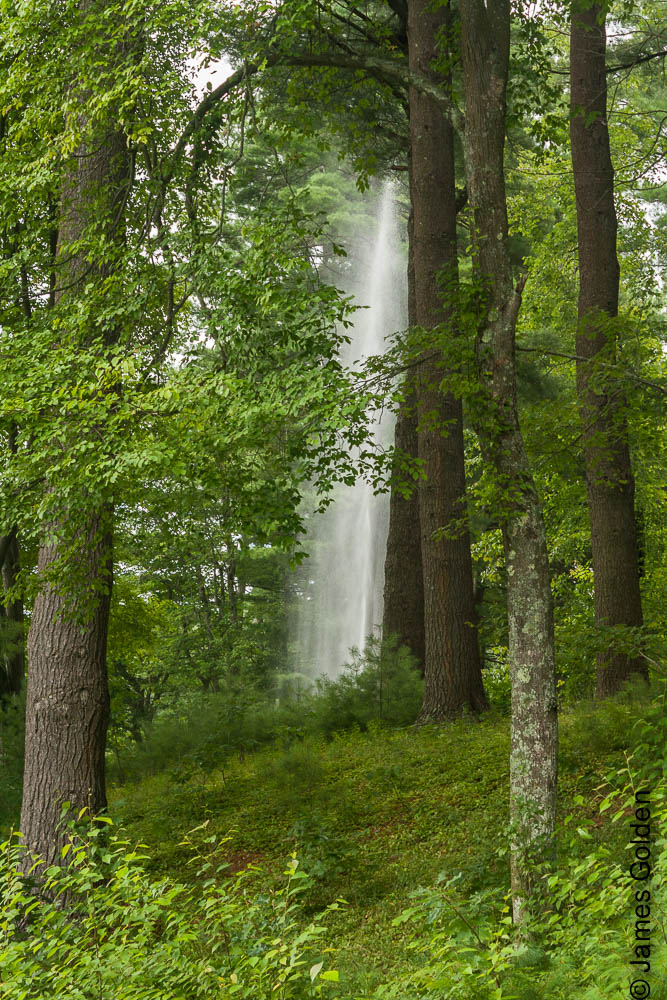
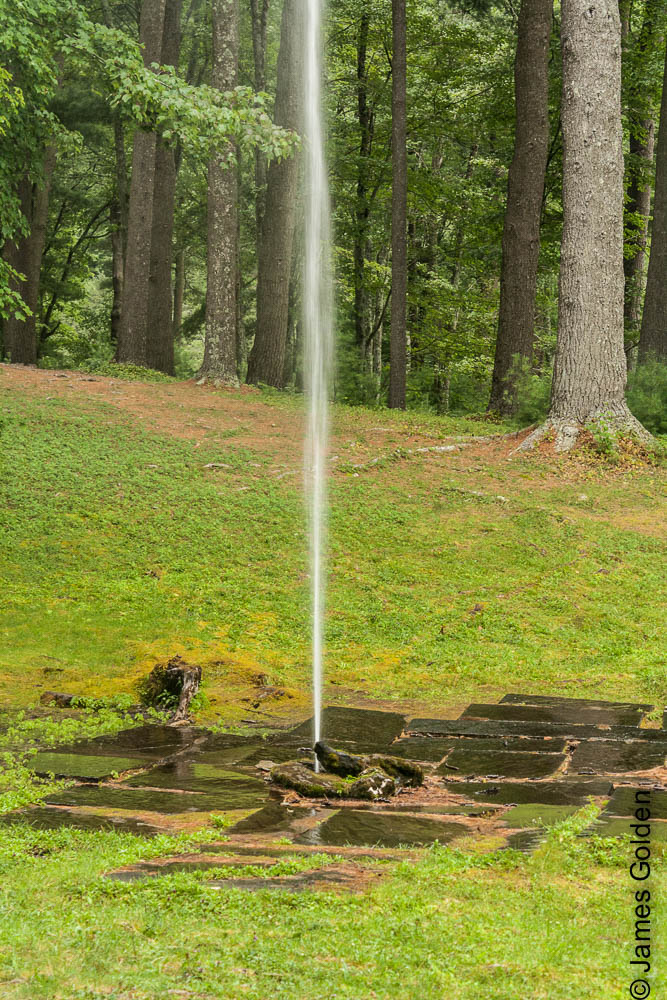 Water sculpture under weeping willows ...
Water sculpture under weeping willows ...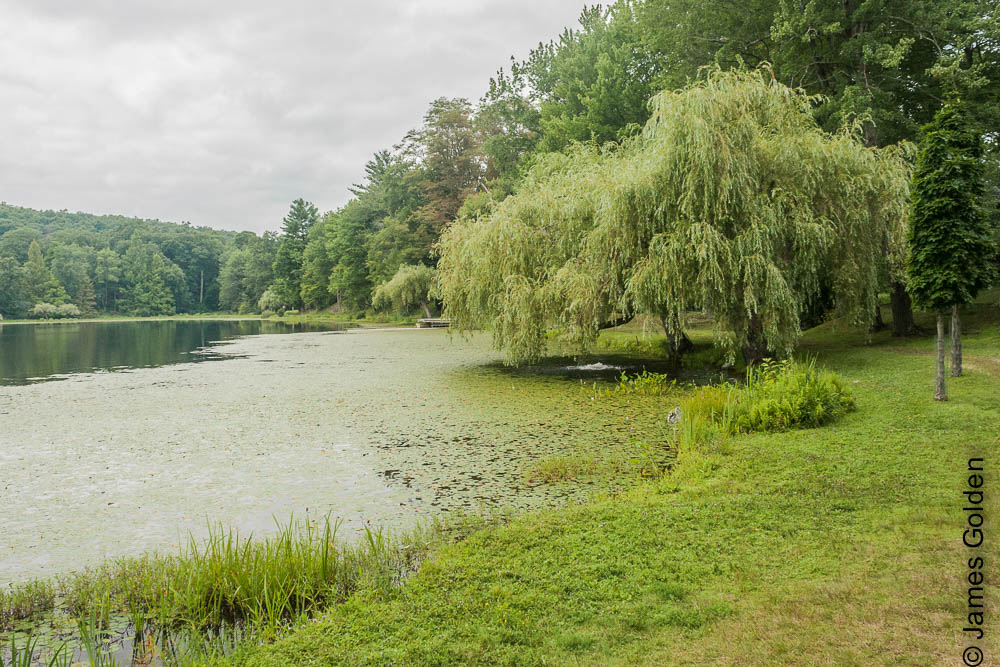
 View across the lake to the oldest part of the garden ...
View across the lake to the oldest part of the garden ...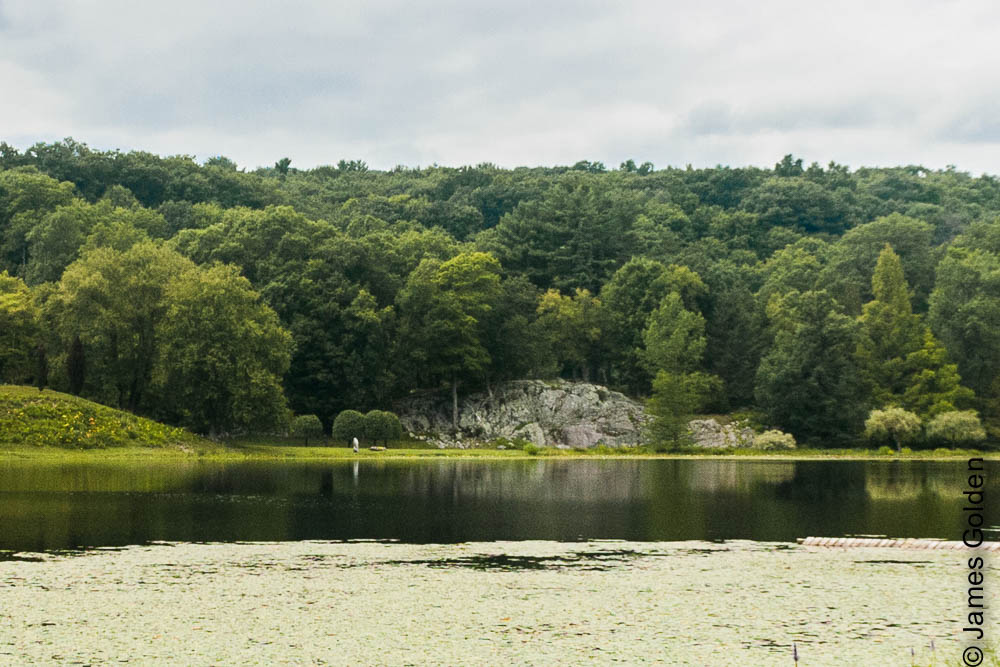 For me, Innisfree will always be a contemplative garden, one best visited alone, or with quiet, thoughtful companions. Though designed and maintained through intensive management, it asks to be seen as a kind of idealized nature, appealing both to the senses and to the mind, concealing its inner workings behind a veil of grace.The garden opens itself easily to exploration ... and it will continue to offer more on return visits. Its seeming simplicity conceals many surprises.
For me, Innisfree will always be a contemplative garden, one best visited alone, or with quiet, thoughtful companions. Though designed and maintained through intensive management, it asks to be seen as a kind of idealized nature, appealing both to the senses and to the mind, concealing its inner workings behind a veil of grace.The garden opens itself easily to exploration ... and it will continue to offer more on return visits. Its seeming simplicity conceals many surprises.